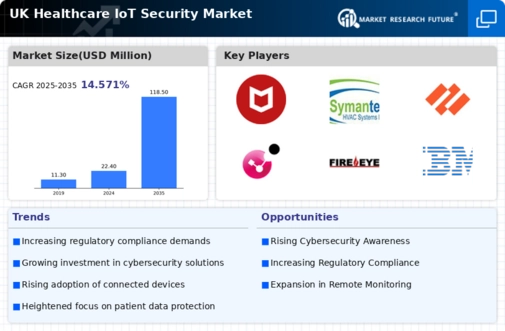Patient-Centric Care Models
The shift towards patient-centric care models in the UK healthcare system is significantly impacting the healthcare iot-security market. As healthcare providers increasingly focus on personalized treatment plans and remote patient monitoring, the reliance on IoT devices has grown. This transition necessitates the implementation of stringent security protocols to ensure the confidentiality and integrity of patient data. With an estimated 40% of patients now using telehealth services, the demand for secure communication channels and data protection measures is more critical than ever. This evolving landscape is likely to drive investments in healthcare iot-security solutions, as organizations strive to maintain patient trust and comply with regulatory standards.
Rising Cybersecurity Threats
The healthcare iot-security market is experiencing heightened demand due to the increasing frequency and sophistication of cyberattacks targeting healthcare systems. In the UK, healthcare organizations are particularly vulnerable, as they manage sensitive patient data and critical medical devices. Reports indicate that cyber incidents in the healthcare sector have surged by over 50% in recent years, prompting a pressing need for robust security measures. This trend underscores the importance of investing in advanced security solutions to protect against data breaches and ransomware attacks. As a result, healthcare providers are prioritizing the implementation of comprehensive security frameworks, which is likely to drive growth in the healthcare iot-security market.
Growing Adoption of Connected Medical Devices
The proliferation of connected medical devices in the UK healthcare sector is a significant driver for the healthcare iot-security market. With an estimated 30% of hospitals now utilizing IoT-enabled devices, the need for effective security measures has become paramount. These devices, ranging from wearable health monitors to smart imaging equipment, generate vast amounts of data that require protection from unauthorized access. As healthcare providers increasingly rely on these technologies to enhance patient care and operational efficiency, the demand for security solutions that safeguard device integrity and data privacy is expected to rise. This trend is likely to propel the healthcare iot-security market forward as organizations seek to mitigate risks associated with device connectivity.
Regulatory Pressures and Compliance Requirements
Regulatory pressures are a driving force in the healthcare iot-security market, particularly in the UK. The introduction of stringent data protection regulations, such as the General Data Protection Regulation (GDPR), has compelled healthcare organizations to enhance their security measures. Non-compliance can result in hefty fines, with penalties reaching up to €20 million or 4% of annual global turnover, whichever is higher. As a result, healthcare providers are increasingly investing in security solutions to ensure compliance and protect patient data. This trend is expected to continue, as organizations recognize the importance of adhering to regulatory requirements while safeguarding their digital assets, thereby fueling growth in the healthcare iot-security market.
Increased Investment in Healthcare IT Infrastructure
Investment in healthcare IT infrastructure is a crucial factor influencing the healthcare iot-security market. The UK government has committed substantial funding to modernize healthcare systems, with an estimated £2 billion allocated for digital transformation initiatives. This investment aims to enhance the efficiency and security of healthcare services, thereby driving the adoption of IoT technologies. As healthcare organizations upgrade their IT infrastructure, they are also recognizing the necessity of integrating robust security measures to protect sensitive patient information. Consequently, this trend is expected to stimulate growth in the healthcare iot-security market as organizations seek to align their security strategies with their technological advancements.























Leave a Comment